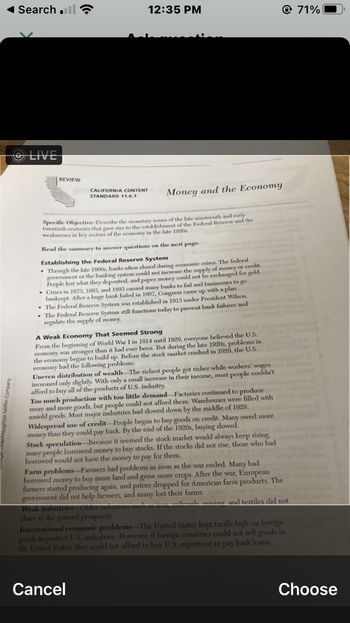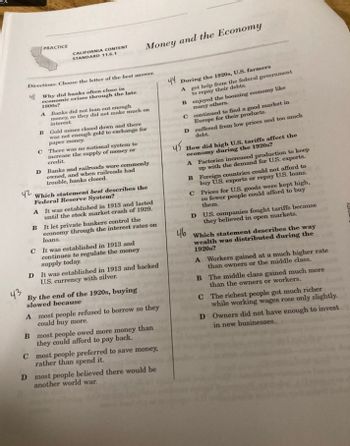Question
Do the reading and answer the questions! You got this!
Do all of them correctly.

Transcribed Image Text:Search.
ⒸLIVE
REVIEW
CALIFORNIA CONTENT
STANDARD 11.6.1
12:35 PM
Money and the Economy
Specific Objective: Describe the monetary issues of the late nineteenth and early
twentieth centuries that gave rise to the establishment of the Federal Reserve and the ticke
weaknesses in key sectors of the economy in the late 1920s.
Read the summary to answer questions on the next page.
Establishing the Federal Reserve System
Through the late 1800s, banks often closed during economic crises. The federal
government or the banking system could not increase the supply of money or credit.
People lost what they deposited, and paper money could not be exchanged for gold.
. Crises in 1873, 1883, and 1893 caused many banks to fail and businesses to go
bankrupt. After a huge bank failed in 1907, Congress came up with a plan.
• The Federal Reserve System was established in 1913 under President Wilson.
• The Federal Reserve System still functions today to prevent bank failures and
regulate the supply of money.
A Weak Economy That Seemed Strong
From the beginning of World War I in 1914 until 1929, everyone believed the U.S.
economy was stronger than it had ever been. But during the late 1920s, problems in
the economy began to build up. Before the stock market crashed in 1929, the U.S.
economy had the following problems:
Uneven distribution of wealth The richest people got richer while workers' wages
increased only slightly. With only a small increase in their income, most people couldn't
afford to buy all of the products of U.S. industry.
Too much production with too little demand-Factories continued to produce
more and more goods, but people could not afford them. Warehouses were filled with
unsold goods. Most major industries had slowed down by the middle of 1929.
Widespread use of credit-People began to buy goods on credit. Many owed more
money than they could pay back. By the end of the 1920s, buying slowed.
Cancel
Stock speculation-Because it seemed the stock market would always keep rising,
many people borrowed money to buy stocks. If the stocks did not rise, those who had
borrowed would not have the money to pay for them.
@ 71%
M
Farm problems-Farmers had problems as soon as the war ended. Many had
borrowed money to buy more land and grow more crops. After the war, European
farmers started producing again, and prices dropped for American farm products. The
government did not help farmers, and many lost their farms.
Weak industries Older industries such
ilmade mining and textiles did not
share in the general prosperity.
International economic problems-The United States kept tariffs high on foreign
goods to protect U.S. industries. However, if foreign countries could not sell goods in
the United States, they could not afford to buy U.S. exports or to pay back loans.
Son
ellas
Choose

Transcribed Image Text:42
43
PRACTICE
CALIFORNIA CONTENT
STANDARD 11.6.1
Directions: Choose the letter of the best answer.
4 Why did banks often close in
economic crises through the late
1800s?
A Banks did not loan out enough
money, so they did not make much on
interest.
Money and the Economy
B Gold mines closed down and there
was not enough gold to exchange for
paper money.
C There was no national system to
increase the supply of money or
credit.
D Banks and railroads were commonly
owned, and when railroads had
trouble, banks closed.
Which statement best describes the
Federal Reserve System?
A
It was established in 1913 and lasted
until the stock market crash of 1929.
B It let private bankers control the
economy through the interest rates on
loans.
C It was established in 1913 and
continues to regulate the money
supply today.
D It was established in 1913 and backed
U.S. currency with silver.
By the end of the 1920s, buying
slowed because
A most people refused to borrow so they
could buy more.
B most people owed more money than
they could afford to pay back.
C
most people preferred to save money,
rather than spend it.
D most people believed there would be
another world war.
44 During the 1920s, U.S. farmers
A
B
C continued to find a good market in
Europe for their products.
D
45
got help from the federal government
to repay their debts.
enjoyed the booming economy like
many others.
46
suffered from low prices and too much
debt.
How did high U.S. tariffs affect the
economy during the 1920s?
A Factories increased production to keep
up with the demand for U.S. exports.
B Foreign countries could not afford to
buy U.S. exports or repay U.S. loans.
Prices for U.S. goods were kept high,
so fewer people could afford to buy
them.
C
D
U.S. companies fought tariffs because
they believed in open markets.
Which statement describes the way
wealth was distributed during the
1920s?
A Workers gained at a much higher rate
than owners or the middle class.
B
The middle class gained much more
than the owners or workers.
C
The richest people got much richer
while working wages rose only slightly.
Owners did not have enough to invest
in new businesses.
D
Expert Solution
This question has been solved!
Explore an expertly crafted, step-by-step solution for a thorough understanding of key concepts.
This is a popular solution
Trending nowThis is a popular solution!
Step by stepSolved in 3 steps
